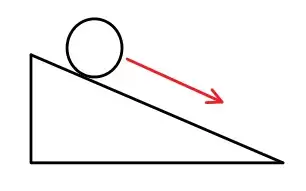Find more at Tech Savvy Youth's Blog. The following article is a TSY Blog post for IB/AP Physics 1.
This is the article discussing Newton’s First Law of Motion. Read through for a detailed explanation!
Find the previous article on Kinematics here.
In the 17th century, Isaac Newton put out three rules for why objects move the way they do. The first law that we will discuss is Newton’s First Law of Motion, which can also be called the “Law of Inertia.”
The two key takeaways from this article are, for Newton’s First Law:
- An object at rest stays at rest.
- An object in motion stays in motion, with the same direction and speed, unless an unbalanced force changes it.
So, we must remember that Newton’s First Law can only work if all forces are balanced; there is no unbalanced force to change it. Essentially, objects will continue their actions unless something interrupts them (the unbalanced force).

Ball Rolling Down a Ramp
An example of this law is with a ball on a flat ramp. Before discussing this example, we must know that objects on a straight path on the ground stop moving because friction opposes their movement, or more clearly, the force of friction opposes them. As long as the surface has friction (some questions involve frictionless surfaces), the ball will slow down or decelerate and come to a stop. Returning to the ball example, a ball on a ramp may be moving 5 mph, and if there were no friction, it would continue at that same speed forever. However, friction gradually slows down the ball. Newton’s First Law of Motion states that if that friction was never present, the ball must keep the same direction and speed forever. Similarly, an object at rest can not magically begin moving unless an external force is applied to the object, like a push, to start its motion.
For more information on friction, feel free to read about Galileo and the concept of inertia.
Furthermore, it’s essential to know that inertia is highly affected by mass. Mass is only dependent on the inertia of an object. An object with a larger mass will change its state of motion slowly. For example, a ball weighing 10 pounds will not roll as much as a ball weighing 5 pounds if we push both balls with the same force because the heavier ball needs more force in the push to move it at the same speed as the lighter ball. Therefore, the ball with a larger mass is resistant to changes in its state of motion.
Since inertia is the tendency of an object to resist “changes to its state of motion,” we can then claim that inertia causes an object to resist changes in its acceleration and velocity. This is because any change in velocity changes the object’s constant state of motion, and the same happens for acceleration, making these unbalanced forces which change the state of inertia of the object.
Signing Off,
Abhijit B. Guttikonda